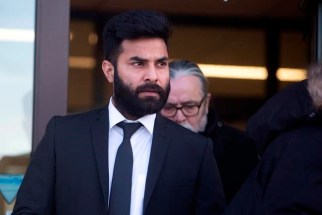Decluttering queen’s Netflix series sparks joy in viewers
Read this article for free:
or
Already have an account? Log in here »
To continue reading, please subscribe:
Monthly Digital Subscription
$0 for the first 4 weeks*
- Enjoy unlimited reading on winnipegfreepress.com
- Read the E-Edition, our digital replica newspaper
- Access News Break, our award-winning app
- Play interactive puzzles
*No charge for 4 weeks then price increases to the regular rate of $19.00 plus GST every four weeks. Offer available to new and qualified returning subscribers only. Cancel any time.
Monthly Digital Subscription
$4.75/week*
- Enjoy unlimited reading on winnipegfreepress.com
- Read the E-Edition, our digital replica newspaper
- Access News Break, our award-winning app
- Play interactive puzzles
*Billed as $19 plus GST every four weeks. Cancel any time.
To continue reading, please subscribe:
Add Free Press access to your Brandon Sun subscription for only an additional
$1 for the first 4 weeks*
*Your next subscription payment will increase by $1.00 and you will be charged $16.99 plus GST for four weeks. After four weeks, your payment will increase to $23.99 plus GST every four weeks.
Read unlimited articles for free today:
or
Already have an account? Log in here »
Hey there, time traveller!
This article was published 08/01/2019 (2530 days ago), so information in it may no longer be current.
Be honest: do you own more than one plastic container of mystery cords? Does your closet overfloweth with old jeans and band/team/marathon T-shirts from who-knows ago? Do all your socks have mates or is it a singles bar up in that drawer? And what’s the current lid-to-container ratio in your Tupperware drawer?
It’s OK. Humans tend to accumulate a lot of stuff — too much stuff, probably. We amass birthday cards and photographs and souvenir mugs. The detritus of being alive.
Some of it is worth keeping. Some of it only seems that way. And Marie Kondo’s new Netflix show, Tidying Up with Marie Kondo, may help you figure out how to take control of your stuff— and possibly your life.

Even if you’ve yet to KonMari your sock drawer, it’s likely you’ve at least heard of Kondo and her signature tidying method. The Japanese organization sensation became a household name with her bestselling 2011 book, The Life-changing Magic of Tidying Up: The Japanese Art of Decluttering and Organizing, which arrived in North America in 2014. The trademarked KonMari method is simple: sort all of your stuff into categories — clothing, books, papers, ‘komono’ (miscellaneous items, such as kitchenware and tools), and sentimental. Keep only those things that “spark joy,” and let go of the rest — after thanking them for their service, of course. A tidy life is a happy life, so her logic goes.
By far and away, the word most often used to describe Kondo’s Netflix show is “soothing.” Tidying Up is, in many ways, the anti-reality reality show. Reality TV is loud. Tidying Up is quiet, gentle. There’s no competition. There’s no judgment. There’s no lurid, gawk-in-horror footage endemic in shows such as Hoarders. There are before-and-after reveals, but they are more satisfying than dramatic. After all, this isn’t a home makeover show. This is, literally, a show about tidying.
And yet, that’s exactly makes the show so compelling and yes, so soothing. The cases here are not particularly extreme; these are simply individuals and families with too much stuff and too few places to put it: the couple with two young children arguing over unscalable mountains of dishes and laundry; the pair of empty-nesters whose recreation room has been taken over by Christmas decorations; or the family of four trying to make it work in a two-bedroom apartment.
Everyday stuff has a way of piling up, and we all have our organizational Waterloo (mine is paper, which is why I have a box of rent receipts from an apartment I lived in a decade ago). Stuff is like snow: you can shovel it but, unless you have a place to put it, you’re mostly just pushing it around. And piles of stuff can be overwhelming and anxiety-producing.
Being unable to find or access what you need in the moment not only creates stress, but avoidance behaviours; how likely are you to cook in your kitchen, for example, if you have to dig through a bunch of stuff to find your pots and pans? That’s also why many self-proclaimed clotheshorses with bursting closets complain they have nothing to wear. As Kondo frequently points out, if you can’t see what you have, you don’t know you have it, which is how one ends up buying seven near-identical black sweaters.
With her impeccably neat bangs and tailored clothes, Kondo herself is tiny and tidy — a calming, yet enthusiastic, presence. Via a translator, she takes people through the KonMari method, offering them gentle, shame-free, but mostly hands-off guidance. Decluttering is hard and often emotional work — and, if there’s a misgiving of the show, it’s that a lot of that work happens off screen — but people emerge from the process visibly changed. They seem lighter. Happier.

Kondo has received her fair share of criticism. Some people believe her method is just for rich people who can replace things that don’t spark joy with things that do. Others are aghast that books might be considered clutter. But Kondo’s whole tidying ethos isn’t about upscale minimalism, nor is it about the pursuit of a certain esthetic — “tidy,” it turns out, is subjective. So is “joy.” If many things spark joy for you, that’s cool. The challenge, then, is finding a way to display or store them. Her method is not prescriptive. There’s lots of room for personalization and interpretation. Kondo doesn’t insist people invest in pricey, complicated storage systems, either. The woman works straight-up miracles with shoeboxes.
Tidying up, on its own, will streamline your life and free up the overwhelming mental clutter that physical clutter tends to create. But the life-changing magic part? That comes from practising gratitude, which is the real foundation of the KonMari method.
Keep only those things that spark joy and let go of the rest– after thanking them for their service, of course.
Before she begins with a client, Kondo greets and thanks the home. It’s almost meditative; eyes closed, palms to the floor. On the show, she engages her clients in this process. Some are visibly uncomfortable, the silence awkward. Others, however, get emotional. They’ve never thought to thank the place that provides them with warmth, shelter, and comfort.

Many of her critics believe that the KonMari method is about throwing stuff away. On the contrary, it’s more concerned with the stuff we keep. A lot of things in our modern lives are disposable, or are treated as such. And it’s easy to view things as disposable when you don’t appreciate them. It might seem silly to hold a T-shirt to your chest and thank it for its service. But by thanking an item for its service and releasing it, or taking better care of the items that still “spark joy,” you learn to appreciate what you have. Kondo’s precision folding is at turns praised and mocked, but here’s the deal: your sweaters keep you warm. You spent money on them. Don’t they deserve to be neatly stored in a drawer instead of dumped in a heap on the floor?
Also apparent within the first three episodes is how much the labour of home organization is shouldered by women — an example of what the French cartoonist Emma dubbed “mental load” in a viral cartoon. “Mental load” refers to the stress of having to be the sole manager of a household. In Episode 3 of Tidying Up, Katrina Mersier is tired of having to keep track of her family’s belongings. At one point, her 12-year-old son confesses that he will “spam his mom’s phone until she answers” if he’s looking for something. By involving the whole family in the tidying process, Kondo teaches people to not only take better care of their stuff, but be more responsible for it, too.
And that’s perhaps the most inspiring thing about Tidying Up. It’s a feel-good reminder that change is possible.
jen.zoratti@freepress.mb.ca
Twitter: @JenZoratti

Jen Zoratti is a Winnipeg Free Press columnist and author of the newsletter, NEXT, a weekly look towards a post-pandemic future.
Our newsroom depends on a growing audience of readers to power our journalism. If you are not a paid reader, please consider becoming a subscriber.
Our newsroom depends on its audience of readers to power our journalism. Thank you for your support.









